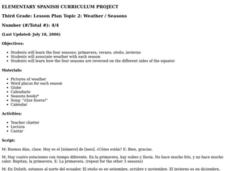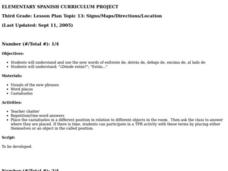Curated OER
Leisure Vocabulary Terms
Introduce your language learners to different sports and leisure activities. Cut out the sixteen flashcards here, and set up a station for your learners to flip through them and acquire the target vocabulary.
Curated OER
¿Qué significa el dibujo? 3
This multiple choice activity serves two purposes! First, you could use this with your young native Spanish speakers to test their reading comprehension. Or you could use this activity with your non-native, beginning Spanish speakers....
Curated OER
Spanglish Exercise 2
Are your English language learners using Spanglish when they don't know the appropriate word? Have them study the chart at the top of the page. First they match the Spanglish phrase to its proper English meaning, and then they translate...
Curated OER
Practica de Pronunciación y Ortografía: fa, fe, fi, fo, fu
Enhance the pronunciation of your Spanish-speaking class by offering them some practice with the syllable combinations of fa, fe, fi, fo, and fu. In the first short exercise, they match the correct word to the sentence it belongs in. In...
Curated OER
En mi familia
Read En mi familia and discuss families with your young Spanish learners. Who is in their family? What are the roles of each person there? Does one person generally cook? Youngsters learn the vocabulary for activities that people do in...
Curated OER
My Family and Our Nationality
After completing the activities included here, your beginning foreign language speakers will be able to name family members, identify a family's place of origin, and write short sentences about family members. They start by listening to...
Curated OER
Future Actions
How do you conjugate a reflexive verb? This plan suggests reading a children's book to your intermediate Spanish speakers. Follow the reading with a PowerPoint slide show that presents reflexive verbs, a sentence using the verb, and a...
Curated OER
La mariposa
Read Angela Royston's Ciclo de vida de la mariposa! You can show your class pictures of different butterflies that live in Mexico or Spain, or have your learners conduct puppet shows with caterpillars and butterflies. How does a...
Curated OER
Cities and Countries Around the World
Briefly introduce your young Spanish speakers to different cities around the world. Identify the country they are located in, what the people are called from those countries, and the country's location on a class map. Make sure to use...
Curated OER
El Dia de Los Muertos
How does the Spanish culture view death? Gain the interest of your learners by showing them a skull (if you can get one). How is this Spanish celebration similar or different than Halloween? As an extension, you could dedicate a class...
Curated OER
Seasons
¿Qué temperado es? Discuss the seasons with your young Spanish learners. Read a book that correlates with whatever season it currently is where you are located. This plan suggests one from Barron's, although any seasonal book will do....
Curated OER
Simple Directions
Where is it? Place a favorite classroom object (a stuffed animal perhaps) around the room and have your young language learners give you directions to find it. They have to tell you whether you should go straight, turn right, etc....
Curated OER
Explore Fish
Read Animals Called Fish with your young Spanish language learners and talk about the different parts of a fish. After teaching terms like huesos, columna vertebral, aletas, escamas, etc, Learners will draw a picture of a fish and label...
Curated OER
Stressed Syllables Worksheet
This worksheet is designed for use with a rule sheet (not included here). Consider making your own rule sheet to find the stressed syllables in each of the 10 words, or remove that column of the page altogether.
Curated OER
Describe Yourself!
Who are you? Where are you from? Teach young Spanish language learners how to identify themselves and where they're from. They draw a picture of themselves to help develop vocabulary for this activity.
Curated OER
Describing People
With a variety of pictures, fourth grade Spanish language learners will review adjectives by describing the appearance of the people in the pictures. You will need to bring in the pictures, and consider creating a word bank of adjectives...
Curated OER
Describing the Planets
Young Spanish language learners review the names of each planet. Then, in pairs, they work to complete the chart provided. What is the composition of each planet? What is the color? They learn how to describe the planets.
Curated OER
Practica de pronunciacion y ortografia: lla, lle, lli, llo, llu
Practice your Spanish pronunciation by recognizing that certain syllables create certain sounds. Five syllable combinations are shown here: lla, lle, lli, llo, and llu. There are twenty words that require the learner to choose the...
Curated OER
Colors and Fruit
Review colors in Spanish by presenting different photographs and asking your charges to identify the colors in each picture. Consider bringing in pictures from Spain, Mexico, or another Spanish-speaking country to make the activity more...
Curated OER
Diminutivos
There are several reasons why Spanish speakers use the diminutive form. Not only is it used to indicate size, but it can also indicate affection. This plan, while not incredibly detailed, does provide some great questions for...
Curated OER
Tour a Museum
Take your youngsters on a virtual tour of a Spanish museum. Select around 10 works of art to show your class. El Prado museum, in Madrid, has a great online database you can use. Select the works of art beforehand, so you're all set for...
Curated OER
Weather/ Seasons
Read Un dia de lluvia with your young Spanish speakers. The firs time through, everyone listens intently. The second time, pass out props that correlate with the story (like pictures of trees and bird). Then, while the teacher reads, the...
Curated OER
Exploring Numbers
Start this short plan by greeting your youngsters in Spanish. In this 15 or 20 minute lesson, you'll review numbers one through 10 before working on numbers up to 20. Use pictures to give learners something visual to count. If time, the...
Curated OER
Animal Noises
The Spanish song, Vengan a Ver Mi Granja, provides young language learners an opportunity to expand their vocabulary. After listening to the sounds, class members name the animals and their habitats, construct puppets of the animals, and...

























